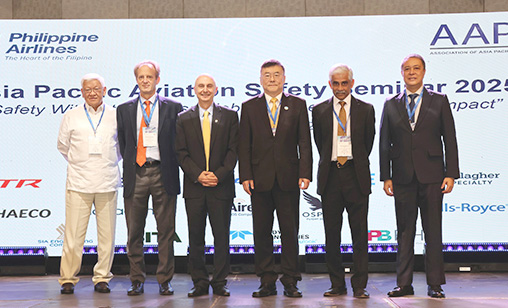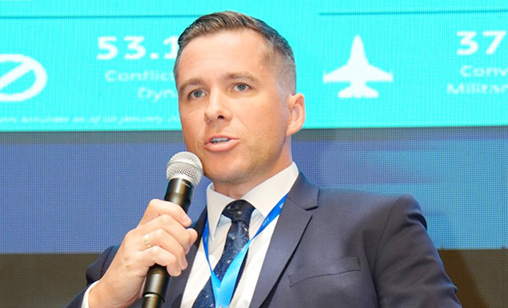Main Story
Dealing with risks of more regional conflicts
It has been more than a decade since Malaysia Airlines flight MH17 was shot down by a Russian missile, killing all passengers and crew on board. Today, the threat to commercial aircraft from conflict zones is much worse. And the airspace over regions of war is not the only concern of the airline industry. Associate editor and chief correspondent, Tom Ballantyne, reports from Manila.
August 1st 2025
It appeared to be a routine flight. Read More » Until the pilot of a Virgin Australia aircraft flying from New Zealand to Australia suddenly received a radio message from a Chinese warship warning him to stay outside a ten-mile exclusion zone because a live-fire exercise was underway. The pilot contacted air traffic control in Australia to ask if they were aware this was happening. The answer was “no”.
In the Tasman Sea, thousands of miles away from their home bases, China’s navy was firing missiles into the sky below a busy air route without informing local air traffic control authorities.
 |
While operating in international waters, the live firings were a breach of accepted protocol, which calls for pre-warnings of such actions. Some 49 flights were diverted from their pre-planned routes as a result of the exercise.
The incident was a stark illustration of the complex threats airlines face that are quite apart from avoiding the known conflict zones of the Middle East, Russia/Ukraine and more recently India/Pakistan and Thailand Cambodia. And not to be overlooked, North Korea. It has launched test missiles across international air routes without warning.
Just how complex this and other threats are to safe flying were outlined to delegates at the mid-month Association of Asia Pacific Airlines (AAPA) air safety seminar (APASS) held this year in Manila. At panel session “Conflict Zone Risk Management Best Practices”, Osprey Aviation Solutions head of risk, Stanislav Bukhman, whose consultancy provides alerts and forecasts to more than 6,000 customers, including airlines and regulators, said from August 2024 to August this year, it had issued a staggering 18,105 “pings”, or alerts, about various incidents impacting aviation.
Apart from events such as warning of the likelihood of conflict erupting between India and Pakistan earlier this year, they included incidents of “spoofing”, or GPS jamming, a growing threat to aviation that disrupts aircraft navigation systems. This more frequent danger was highlighted when Russia was accused of jamming the GPS of an airplane with European Union president, Ursula von der Leyen, on board as it approached an airport in Bulgaria. Having lost his navigation systems, the pilot had to circle for an hour before landing guided only by paper maps.
Osprey was established in 2017 with four employees. Its staff numbers 52 today. It analyses a minimum of 200,000 data sources, reporting at least 300 events a day.
 |
Circumnavigating conflict zones and dealing with GPS jamming is placing additional stress on cockpit crew, Captain Matsumoto (Max) Hideaki, a B787 pilot and Safety General Manager, Corporate Safety at All Nippon Airways, told APASS attendees.
“We are constantly training for a multitude of scenarios such as adverse weather conditions and aircraft malfunctions. But recently one of the most complex issues has become navigating airspace near conflict zones. They are real time threats that can materialise with little to no warning,” he said.
Matsumoto said long before stepping into the cockpit, the pre-fight briefing becomes critical. “We are not just looking at the weather or making fuel plans. Information is gathered and an assessment is done by the dispatchers and other related safety divisions well before the flight,” he said.
“They are meticulously reviewing and summarising, gathering sources from the regulators, international bodies like EASA (European Air Safety Agency), the U.S. Federal Aviation Administration, the International Air Transport Association and sources such as Osprey.
“The question is: what are the specific threats? Are they conventional military activities? Are there groups with anti-aircraft capabilities? What is the maximum altitude of these threats?
“The reliability of this information is paramount. We are constantly weighing the credibility of the sources. Is the information up-to-date? Is it specific enough to be actionable or has it become such?”
The cockpit crew also keeps a vigilant watch on the Guard Frequency, 121.5, used by military activity, he added.
 |
Matsumoto pointed to other operational issues resulting from avoidance of conflict zones. These include longer flight times due to re-routing, crew fatigue and the need for an additional pilot on board a flight at a time of pilot shortages.
“Also, there are human factors. The stress and psychological impacts on crew are significant. We are trained to remain calm under pressure but the thought of what could happen is always present,” he said.
“What if we have a medical emergency? What if we have a technical issue that requires a diversion? We brief on emergency procedures like loss of communication. These are scenarios we hope to never encounter but we must be thoroughly prepared.”
Commitment to safety is non-negotiable, “however to uphold this commitment, we must be empowered with the best possible information. The most significant challenge, therefore, is not the existence of the conflict itself, but the battle for information and clarity in the fog of war. And the safety of global air travel depends on it”, he said.
Keeping up with fast changing situations also is a challenge for regulators, who play a critical role in issuing NOTAMs, (Notices to Airmen) about developments or threats. EASA Southeast Asia representative, David Waller, said conflict zones are a very hard challenge for aviation today.
“The risks are there, but the information available is often incomplete or very fast moving. We can try and help airlines navigate this uncertainty by providing highly practical and hopefully harmonized guidance,” he said.
With civil aircraft - passenger and cargo - routinely crossing multiple borders and regions far away from their home bases, they are facing unpredictable risks.
“There has been unreliable communication between military and civil authorities. We have learned some very hard lessons. So, the downing of Malaysia Airlines flight MH17 in 2014 showed that even an aircraft at altitude and flying a published route can be at direct risk from conflict on the ground.”
A structured support for decision making is essential, Waller said. “What can regulators contribute? First of all, co-ordination.
“Regulators such as EASA can help connect States, airlines and intelligence sources as Osprey does, which is an intelligence consultancy EASA employs. The key is transparency and tidiness.
“Delays in sharing information can put flights at risk. By publishing advisories quickly, even if details are incomplete, we aim to deliver to airlines actionable information without delay.
“This has to be global. Risks don’t stop at borders. It is why this information is made available worldwide. It is why we work with ICAO, the FAA and others to push for harmonisation.
“Because inconsistent or fragmented messages undermine safety.
“Conflict zones don’t respect borders and neither should our safety solutions. The lesson of MH17 is early warnings and transparency save lives.
“Regulators like EASA cannot replace the judgement of airlines or the sovereignty of states, but we can help connect the dots, turning fragmented intelligence into clear guidance and promoting international consistency.”
Spoofing events are not exclusively the result of military activities in conflict zones – a handheld GPS jammer can be purchased online for as little as $20 – but it is clear the majority of them certainly are.
IATA’s Global Aviation Data Management Flight Data eXchange has reported the number of GPS signal loss events increased by 220% between 2021 and 2024.
With continuing geopolitical tensions, it is difficult to see this trend reversing, certainly in the near term. It is becoming worse rather than improving.
Speaking during a panel session “GNNS/GPS Spoofing: Threats to Navigation and Aviation Safety” at APASS, Civil Air Navigation Services Organisation Asia-Pacific director, Soh Poh Theen, said the GNNS (Global Navigation Satellite System) is the cornerstone of modern aviation.
Vulnerabilities include ionosphere disturbances, unintentional interference and intentional interference such as jamming and spoofing.
When it happens recovery time for avionics can exceed 30 minutes and it can lead to a missed approach while landing, loss of separation or worse, he said.
Delegates were told jamming episodes are not only occurring around conflict zones. In the Asia-Pacific for example, there were an astounding 123,333 events involving bad GPS jamming through June and July this year.
What is clear is cockpit crew are well aware of the issue and are being trained to cope with it.